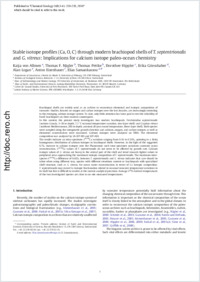Stable isotope profiles (Ca, O, C) through modern brachiopod shells of T. septentrionalis and G. vitreus: Implications for calcium isotope paleo-ocean chemistry
- Allmen, Katja von Department of Geosciences, University of Fribourg, Switzerland
- Nägler, Thomas F. Institute of Geological Science, University of Bern, Switzerland
- Pettke, Thomas Institute of Geological Science, University of Bern, Switzerland
- Hippler, Dorothee Dept. of Sedimentology and Marine Geology, VU University of Amsterdam, The Netherlands
- Griesshaber, Erika Dept. of Earth- and Environmental Sciences, Ludwig-Maximilian University, Munich, Germany
- Logan, Alan Centre for Coastal Studies, University of New Brunswick, Saint John NB, Canada
- Eisenhauer, Anton Leibniz Institute of Marine Sciences, IFM-GEOMAR, Kiel, Germany
- Samankassou, Elias Department of Geosciences, University of Fribourg, Switzerland - Section of Earth and Environmental Sciences, University of Geneva, Switzerland
-
09.10.2009
Published in:
- Chemical Geology. - 2010, vol. 269, no. 3-4, p. 210-219
English
Brachiopod shells are widely used as an archive to reconstruct elemental and isotopic composition of seawater. Studies, focused on oxygen and carbon isotopes over the last decades, are increasingly extending to the emerging calcium isotope system. To date, only little attention has been paid to test the reliability of fossil brachiopods on their modern counterparts.In this context, the present study investigates two modern brachiopods, Terebratulina septentrionalis (eastern Canada, 5–30 m depth, 7.1 °C seasonal temperature variation, two-layer shell) and Gryphus vitreus (northern Mediterranean, 200 m depth, constant all-year round temperature, three-layer shell). Both species were sampled along the ontogenetic growth direction and calcium, oxygen, and carbon isotopes as well as elemental concentration were measured. Calcium isotopes were analyzed on TIMS. The elemental composition was analyzed by LA-ICP-MS and ICP-AES.The results indicate an intra-specimen δ44/40Ca variation ranging from 0.16 to 0.33‰, pointing to a fairly homogenous distribution of calcium isotopes in brachiopod shells. However, in the light of the suggested 0.7‰ increase in calcium isotopes over the Phanerozoic such intra-specimen variations constrain ocean reconstruction. δ44/40Ca values of T. septentrionalis do not seem to be affected by growth rate. Calcium isotopic values of G. vitreus are heavy in the central part of the shell and trend towards lighter values in peripheral areas approaching the maximum isotopic composition of T. septentrionalis. The maximum inter-species δ44/40Ca difference of 0.62‰ between T. septentrionalis and G. vitreus indicates that care should be taken when using different taxa, species with different strontium content or brachiopods with specialized shell structure, such as G. vitreus, for ocean water reconstruction in terms of Ca isotopic composition. T. septentrionalis may record Ca isotopic fractionation related to seasonal seawater temperature variations in its shell but this is difficult to resolve at the current analytical precision. Average δ¹⁸O-derived temperatures of the two investigated species are close to on-site measured temperatures.
- Faculty
- Faculté des sciences et de médecine
- Department
- Département de Géosciences
- Language
-
- English
- Classification
- Palaeontology
- License
- License undefined
- Identifiers
-
- RERO DOC 17188
- DOI 10.1016/j.chemgeo.2009.09.019
- Persistent URL
- https://folia.unifr.ch/unifr/documents/301503
Statistics
Document views: 76
File downloads:
- samankassou_sip.pdf: 169
